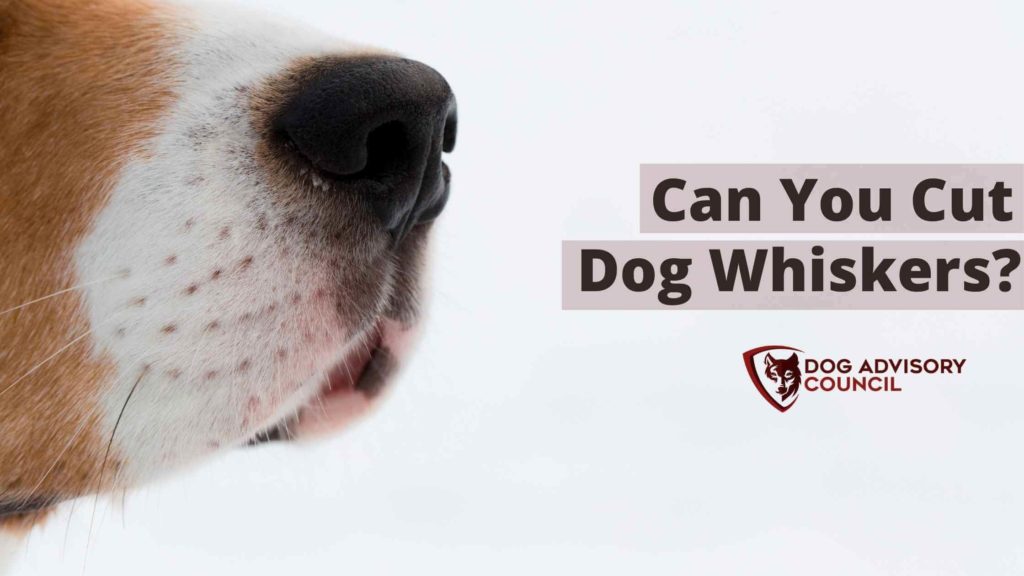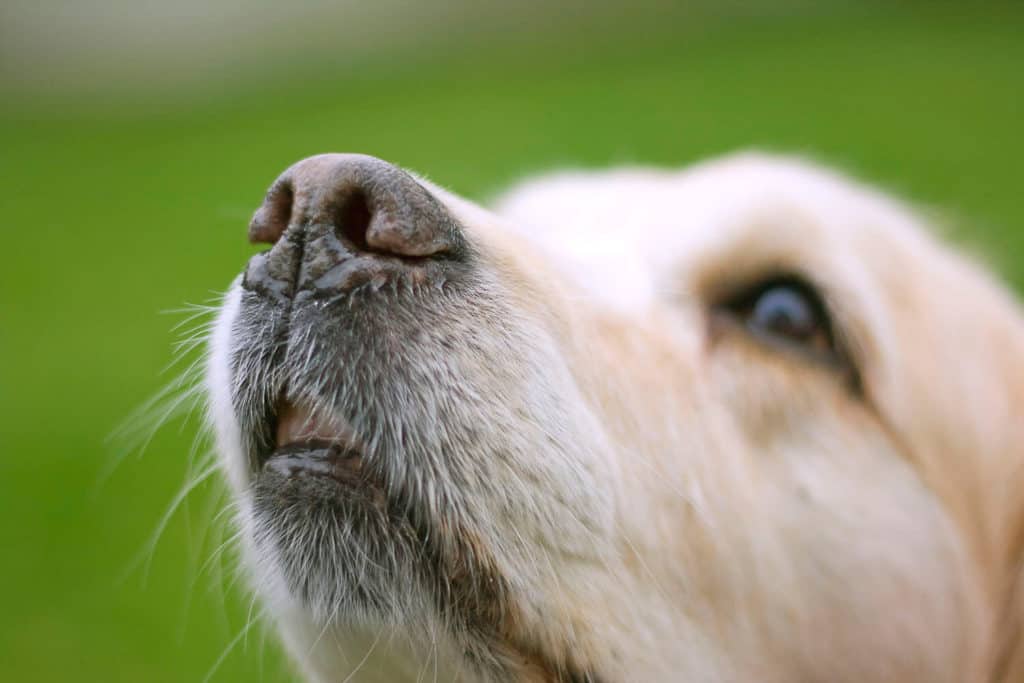
Dogs have many quirks to their furry bodies, many of which are dog breed specific. One detail that dogs all have in common, though, is whiskers. Are you wondering what they are, why they’re necessary, and if can you cut dog whiskers? Read on!
You can trim dog whiskers, but most experts in dog physiology agree that you SHOULDN’T cut a dog’s whiskers. These wiry hairs are key parts of their body for interacting with their environment, protecting themselves, and even communicating with other dogs.
Below, you’ll learn about what they’re used for, their importance to your dog’s body, the different kinds of whiskers your dog has, and what it means if you do cut them.
What do dogs use their whiskers for?
From the beginning of dog breeding to today’s day and age, the use of whiskers has stayed, more or less, the same. They are key for:
- Navigation
- Relaying environmental data
- Spatial awareness
- Protection
Navigation
Dogs’ whiskers are made to help them understand how to move through the world around them. Similar to security cameras, they will help the dog understand how to safely move throughout the environment, even in the dark!
Relaying environmental data
Regardless of whether this is “environmental” in an outdoor sense or not, whiskers will help your dog understand what is around them. They use their whiskers, similar to a topographic map, to get a better feel for what is around them and how they can move throughout the space.
You can also see this if you take your dog hunting (be it animal hunting or toy hunting). Dogs rely on their whiskers to understand how their prey is moving so that they can decide how best to approach it. This includes speed, direction, and other important data.
Spatial awareness
Ever wonder how your dog just knows that he can fit through that hole in the fence? You can blame his whiskers rather than his mischievous streak! They are key to helping your dog understand his own size in relation to the things around him. They can also feel air currents and understand wind directions.
Protection
Acting as sensory buffers, too, whiskers are important for your dog to avoid tree branches or “dangerous” things in their environment. In this case, whiskers act as a warning system to not get too close with their sensitive nose or eyes. Since they can feel air currents, this way they can figure out the size of nearby or incoming objects.
So, basically, no matter how you look at it, whiskers are crucial parts of a dog’s body for how he interacts with the world around him!
How important are whiskers for dogs otherwise?
Besides those general uses for a dog’s interaction with the world, whiskers also are key in body language. This is true in terms of his humans interpreting his body language, but other dogs as well.
For example, if a dog is relaxed and happy, his whiskers often fold down along his cheeks, chin, etc. His “radar” is down because it’s calm with his favorite humans. If he is feeling tense or unsure, his whiskers will pop up at all angles and start detecting what’s going on around him to help him determine how to react.
You can see how comfortable a dog is with another dog by how his whiskers react — and vice versa! While subtle, it’s great to have another physical indicator of your dog’s comfort level in a stressful or new situation!
Are there different kinds of whiskers?
All whiskers are wiry, though they vary in length and location. Rooted deep in their skin, these adaptable and moveable hairs are lots of nerves right at their base that transfer sensory signals to the brain to help dogs understand what’s happening. However, dogs have different kinds of whiskers! These include:
- Mystacial whiskers
- Genal whiskers
- Interramal whiskers
- Supraorbital whiskers
Mystacial whiskers
These are the shortest whiskers on dogs, typically. They are on the upper lip of a dog and stick straight out. Their main role is to help dogs detect and find food around them.
Genal whiskers
These are on their cheeks and along their jawline. They tend to be at all angles and vary in length. These whiskers work to help increase your dog’s peripheral vision.
Interramal whiskers
Located under the chin, these often are longer whiskers, too, and are helpful to increase your dog’s “vision” under them so that they can somewhat understand what’s going on directly under them even if they can’t see it.
Supraorbital whiskers
As the name may suggest, these whiskers are all around the top and outside edge of the eyes. These whiskers are mostly responsible for making sure your dog doesn’t injure his eye or snout as he explores his environment.

What happens if I cut a dog’s whiskers?
While a dog’s whiskers have no pain receptors and are harmless to cut, you can expect some effects of cutting a dog’s whiskers such as a change in your dog’s overall behavior and understanding of the world around them. After all, whiskers do a lot for your dog!
If you cut a dog’s whiskers, you can expect him to run into things a lot more, and generally, be disoriented and confused as he tries to figure out his environment by only relying on his eyes and nose.
Cutting your dog’s whiskers will be like putting blinders on their eyes or ear plugs in their ears.
Technically, you can trim or cut a dog’s whiskers—many dog groomers and dog breeders do it, especially before a dog show—but it’s not recommended by most dog experts.
Again, it’s simply because a dog’s whiskers do a lot for them in comfort and protection. It would be the equivalent of putting an eye patch on a human. Sure, we can navigate around, but it makes things a lot harder!
Is it painful to cut a dog’s whiskers?
If you are firm on cutting your dog’s whiskers, remember to clip them cleanly and never, ever pluck them out. Since their roots are loaded with sensory nerve endings, plucking them completely out (assuming your dog lets you) is very painful and distressing for your poor dog.
Do dog whiskers grow back?
Accidentally read this after you’ve been clipping or cutting your dog’s whiskers? Don’t worry, they will grow back! The amount of time that they do grow back will vary, but whiskers do grow back after they have intentionally or accidentally been cut.
If you think that you can simply clip whiskers and never have to see their unruly sight again, this is sure to be a disappointment — a common problem with those who professionally show their dogs.
Do dog whiskers fall out?
Notice that your dog’s whiskers have fallen out even though you’ve never been anywhere near them with a pair of scissors? Don’t worry, this can happen from time to time. Sometimes puppies will shed their whiskers as they develop and grow new ones. The absence of whiskers isn’t a disaster, but try to keep an eye on their regrowth.
Why is my dog losing whiskers?
As mentioned, whisker loss does happen to dogs sometimes, through no fault of your own. However, whisker loss can be a sign that something else is going on! Common problems could include:
- Stress or change;
- Malnutrition;
- Sickness.
Stress or change
If your dog is stressed or has undergone a change in his home (moving into a new home, or adding a new pet or mini human to his current home), sometimes the stress can cause his whiskers to shed. It may be all of the whiskers or just some of them. They will grow back, as mentioned.
If you notice this happening, though, it might mean that you should try to help your dog calm down by spending lots of quality time with familiar schedules and people. This can help ease his stress a lot!
Malnutrition
Especially common with puppies that come from puppy mills or abusive homes. Malnutrition is one of the most common reasons for a dog’s whiskers to fall out on their own.
With a proper diet and stability, they will grow back better and stronger than ever! If you notice this happening with your own dog, check with a bet to see what’s going on with this diet!
Sickness
In certain cases, sickness is a sign of your dog’s whiskers falling out, too. This is normally combined with other symptoms, but if you don’t think it’s diet or an increase in stress, you’ll want to get him looked at by a vet to see if there’s something else going on!
I hate the sight of whiskers. What should I do?
Maybe you’re here because you’re looking for permission to cut their dog’s whiskers. The honest truth is that it’s regularly done even by professional dog groomers and dog trainers who know the difference before a show dog competition.
As we’ve said, it technically can be done, and it won’t cause your dog any long-term harm — especially since they grow back. But, it becomes a question as to why you are doing it.
If you hate the sight of whiskers — we get it, they’re wiry and ruin photos with their strange angles — then it may be the moment to take a look at your mindset! Your dog needs these whiskers to better understand what’s going on around him, as well as communicate with his doggy friends.
While they may be unsightly, they’re important to your dog’s health and general well-being. Is a “ruined” photo really worth compromising that?
How to trim around dog whiskers
What can you do since you should never cut your dog’s whiskers completely and risk harming your dog?
The answer to that is you can trim around the dog’s whiskers with scissors without harming your dog if done correctly. Here are a few tips:
- Hold the scissors parallel to your dog’s face when cutting;
- Trim a little at a time, being very careful not to cut your dog’s whiskers;
- Have someone help you hold your dog still during this process;
- Avoid using electric clippers, as they may cause you to cut too much.
In general
From navigation to body language, your dog’s whiskers have a lot of roles to fill, and tasks to do!
We know it may be hard to resist the urge to snip away at those pesky whiskers, but we promise, your dog will thank you for it in the long run. After all, they’re there for a reason!
It certainly gives you a bit more appreciation for those long, crooked facial hair, right?
